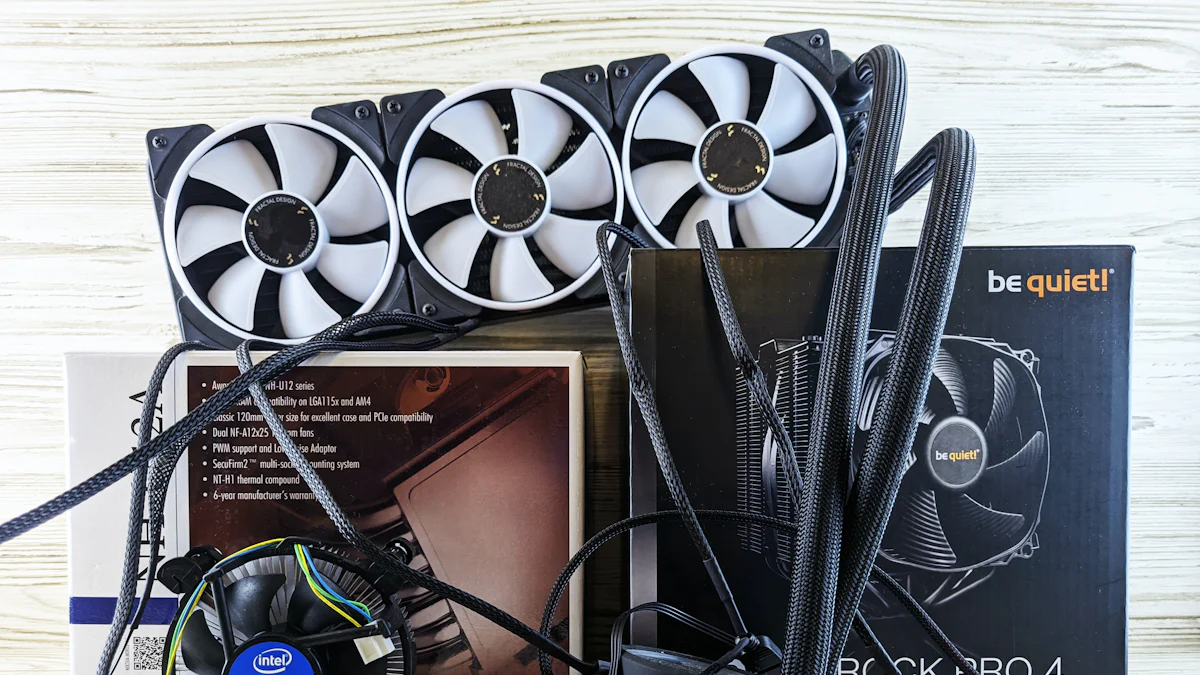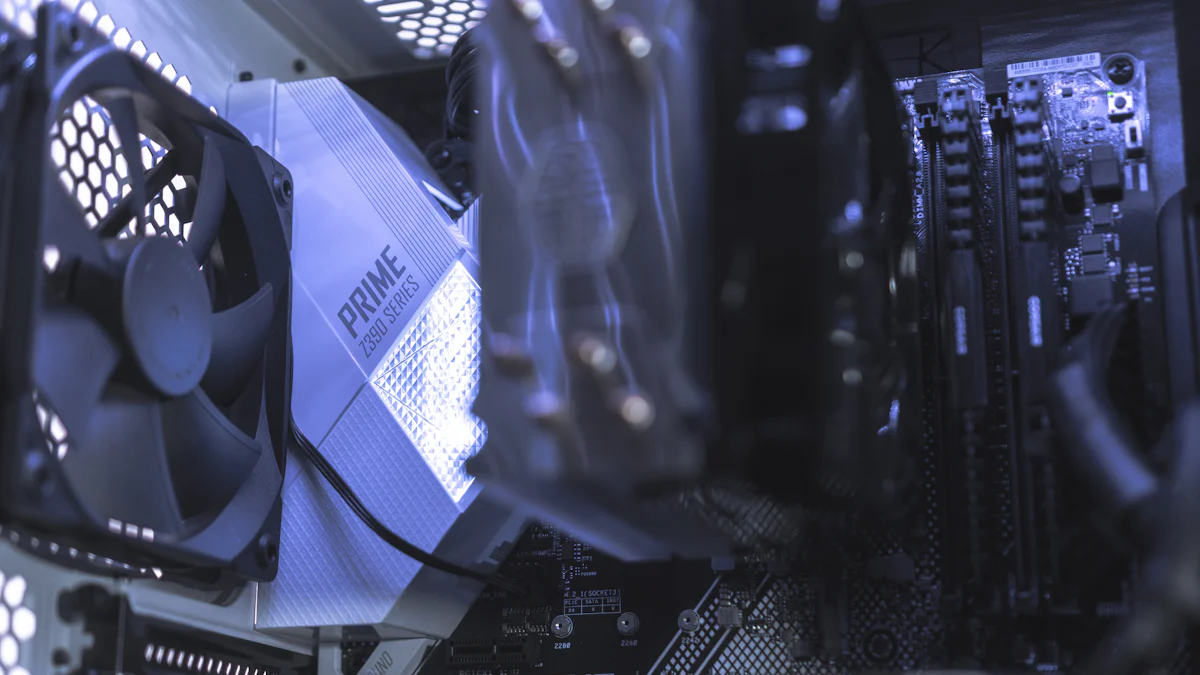Decoding the H22A Cooling Fan Sensor System

The H22A engine stands as a remarkable piece of engineering in the automotive world. The cooling fan sensor system plays a pivotal role in maintaining optimal engine performance. This system ensures that the engine operates within safe temperature limits, preventing overheating and potential damage. A well-functioning cooling fan sensor system enhances the longevity and efficiency of the engine. Understanding the h22a cooling fan temperature sensor location becomes crucial for anyone looking to maintain or upgrade their vehicle's cooling system. This blog aims to provide valuable insights into this essential component.
Understanding the H22A Engine
Overview of the H22A Engine
The H22A engine represents a pinnacle of engineering prowess. This engine features a 16-valve DOHC head, which enhances airflow and efficiency. The engine starts delivering peak performance at 5,800 rpm. The H22A Redtop version boasts dome pistons, increasing the compression ratio to 11. This design choice results in an impressive 220 HP at 7,200 rpm and 221 Nm at 6,500 rpm. The engine uses 35 mm intake valves and 30 mm exhaust valves. The throttle body measures 60 mm, except for the H22A Redtop, which uses a 62.5 mm throttle body.
Role of the Cooling System
The cooling system plays a crucial role in maintaining engine longevity. The system ensures that the engine operates within safe temperature ranges. Overheating can lead to severe damage and reduced engine life. A well-maintained cooling system prevents these issues and extends the engine's lifespan.
The cooling system also impacts performance significantly. The system regulates the engine temperature, ensuring optimal performance levels. Engines perform best within specific temperature ranges. The cooling system maintains these conditions, allowing the engine to deliver consistent power and efficiency.
H22A Cooling Fan Temperature Sensor Location
Identifying the Sensor Location
The h22a cooling fan temperature sensor location holds significant importance for vehicle maintenance. The sensor resides in a strategic position within the engine bay. The cylinder head near the upper radiator hose connection houses the sensor. This placement allows the sensor to accurately gauge the engine's temperature. The sensor's proximity to the coolant flow ensures precise readings.
The h22a cooling fan temperature sensor location includes two distinct switches. One switch informs the temperature gauge on the dashboard. The other switch directly controls the radiator fans. This dual-switch setup enhances the system's reliability. Each switch plays a crucial role in maintaining optimal engine temperatures.
Accessing the Sensor for Maintenance
Accessing the h22a cooling fan temperature sensor location requires some preparation. The engine must cool down before any maintenance begins. A hot engine poses safety risks. Once the engine cools, the hood should open to provide access. The upper radiator hose serves as a guide to locate the sensor.
The h22a cooling fan temperature sensor location may require the removal of certain components. The removal of the air intake or other obstructions may be necessary. This step provides a clear path to the sensor. Careful handling of surrounding parts prevents accidental damage.
Regular inspection of the h22a cooling fan temperature sensor location ensures optimal performance. Visual checks help identify any signs of wear or damage. Any corrosion or loose connections require immediate attention. Proper maintenance of the sensor location contributes to the engine's longevity.
Components of the Cooling Fan Sensor System

Key Components
Sensors
The cooling fan sensor serves as a critical component in the H22A engine. The sensor detects temperature changes in the engine. Accurate readings ensure proper fan activation. The sensor's placement near the upper radiator hose allows precise monitoring. Regular inspection of the sensor prevents overheating issues.
Control Units
The control unit processes signals from the sensor. This unit determines when to activate the cooling fan. Proper functioning of the control unit ensures engine safety. The unit integrates with the vehicle's ECU for seamless operation. Maintenance of the control unit enhances system reliability.
How Each Component Functions
Sensor Operation
The sensor measures the engine's temperature. Temperature changes trigger the sensor to send signals. These signals inform the control unit about the engine's condition. Correct sensor operation prevents engine damage. Regular testing of the sensor ensures accurate performance.
Control Unit Processing
The control unit receives signals from the sensor. Signal processing determines fan activation timing. The unit communicates with the ECU to maintain optimal temperatures. Proper processing by the control unit prevents engine overheating. Upgrading the control unit can improve system efficiency.
Product Information:
Installation of a new electric fan requires precise wiring.
Testing ensures correct fan direction and operation.
Adjustments in the Hondata ECU optimize fan settings.
Understanding these components and their functions ensures effective cooling system management.
How the Cooling Fan Sensor System Works
System Operation
Signal Processing
The cooling fan sensor system processes signals to ensure efficient operation. The sensor detects temperature changes in the engine. The sensor sends these signals to the control unit. Accurate signal processing is essential for timely fan activation. Regular checks on the sensor's functionality prevent overheating issues.
Fan Activation
Fan activation relies on precise signal interpretation. The control unit uses signals to determine when to activate the fan. Proper fan activation maintains optimal engine temperature. This process prevents engine damage and ensures consistent performance. Testing the fan regularly confirms correct operation.
Interaction with Other Engine Systems
Integration with the ECU
The cooling fan sensor system integrates with the Engine Control Unit (ECU). This integration allows seamless communication between components. The ECU uses data from the sensor to adjust engine settings. Proper integration enhances overall engine efficiency. Upgrading the ECU can improve system responsiveness.
Feedback Mechanisms
Feedback mechanisms play a crucial role in system efficiency. The cooling fan sensor provides real-time data to the ECU. This data helps in adjusting fan speed and timing. Effective feedback mechanisms ensure the engine remains within safe temperature limits. Regular monitoring of these mechanisms supports engine longevity.
Scientific Research Findings:
H22a swap cooling issue: Issues with overheating can arise after modifications.
Best solution for cooling setup: Compatibility of parts affects cooling efficiency.
Understanding the operation and interaction of the cooling fan sensor system ensures optimal engine performance. Regular maintenance and upgrades enhance system reliability.
Common Issues with the Cooling Fan Sensor System
Sensor Malfunctions
Causes of Sensor Failure
The cooling fan sensor can experience various failures. Exposure to extreme temperatures often leads to sensor damage. Corrosion on the sensor's connectors disrupts signal transmission. Wear and tear from prolonged use also contribute to sensor failure. Incorrect installation or handling during maintenance may damage the sensor.
Symptoms of Malfunction
A malfunctioning cooling fan sensor presents several symptoms. The engine may overheat due to improper fan activation. The cooling fans might run continuously, draining the battery. Erratic temperature readings on the dashboard gauge indicate sensor issues. The "Check Engine" light may illuminate, signaling a problem with the sensor.
Control Unit Failures
Diagnostic Indicators
Control unit failures manifest through specific indicators. The cooling fan may not activate when necessary. Inconsistent fan operation suggests control unit issues. Diagnostic tools reveal error codes related to the control unit. The engine may overheat despite a functioning sensor, pointing to control unit failure.
Repair Options
Repairing control unit failures involves several options. Technicians often perform software updates to resolve minor issues. Replacing faulty wiring or connectors restores proper function. In some cases, replacing the entire control unit becomes necessary. Upgrading to a more advanced control unit enhances system reliability.
Case Studies:
H22a swap cooling issue: A turbocharged H22A swap experienced overheating. The solution involved upgrading the cooling system components.
F20/H22 complete cooling system upgrade: A Civic chassis underwent a complete cooling system overhaul. The process addressed existing issues and improved overall performance.
Regular inspection and maintenance of the cooling fan sensor system prevent common issues. Understanding these problems ensures timely intervention and prolongs engine life.
Diagnosing Problems in the Cooling Fan Sensor System
Tools and Techniques
Diagnostic tools
Effective diagnosis of cooling fan sensor system issues requires specific tools. A multimeter measures voltage, current, and resistance. This tool helps in identifying electrical problems. An OBD-II scanner reads error codes from the vehicle's ECU. This scanner provides insights into potential sensor or control unit failures. Infrared thermometers measure engine temperature without direct contact. These thermometers help verify sensor readings.
Step-by-step diagnostic process
A systematic approach ensures accurate diagnosis. Begin by visually inspecting the sensor and wiring for damage or corrosion. Use a multimeter to test the sensor's electrical connections. Verify the sensor's resistance against manufacturer specifications. Connect an OBD-II scanner to the vehicle's ECU. Check for any stored error codes related to the cooling system. Use an infrared thermometer to compare actual engine temperature with sensor readings. Confirm that the cooling fan activates at the correct temperature.
Common Diagnostic Challenges
Misinterpretation of signals
Misinterpretation of signals often complicates diagnostics. Incorrect sensor readings may lead to false conclusions. Ensure that all diagnostic tools function correctly. Verify calibration before use. Cross-reference sensor data with actual engine conditions. This practice helps in identifying discrepancies.
Overlapping symptoms with other issues
Overlapping symptoms present another challenge. Cooling system problems may mimic other engine issues. Overheating could result from a faulty thermostat or water pump. Erratic temperature readings might indicate a failing gauge. Comprehensive diagnostics require a holistic approach. Consider all potential causes before concluding.
Maintenance Tips for the Cooling Fan Sensor System
Regular Inspection
Visual Checks
Regular visual inspections play a crucial role in maintaining the cooling fan sensor system. You must examine the sensor and its surrounding components for any signs of wear or damage. Look for corrosion on connectors, which can impede signal transmission. Ensure that all wires remain intact and securely connected. A thorough visual check helps identify potential issues before they escalate.
Sensor Testing
Testing the sensor guarantees accurate performance. Use a multimeter to measure the sensor's resistance. Compare the readings with manufacturer specifications to confirm proper operation. Conduct tests periodically to ensure the sensor functions correctly. Accurate sensor readings prevent overheating and maintain engine efficiency.
Preventive Measures
Cleaning and Upkeep
Proper cleaning and upkeep extend the life of the cooling fan sensor system. Remove any dirt or debris from the sensor and its connectors. Use a soft brush or compressed air to clean hard-to-reach areas. Ensure that the sensor remains free from moisture, which can cause corrosion. Regular cleaning maintains optimal sensor performance.
Timely Replacements
Timely replacements of worn-out components prevent system failures. Replace the sensor if it shows signs of damage or provides inaccurate readings. Consider upgrading to a more advanced sensor for improved reliability. Regularly inspect other cooling system parts, such as hoses and fans, for wear. Proactive replacements enhance the overall efficiency of the cooling system.
Event: A 92 F20B swapped Civic SI underwent a complete cooling system overhaul. The process addressed major issues and prepared the car for tracking. This example highlights the importance of regular maintenance and timely upgrades in ensuring optimal performance.
Implementing these maintenance tips ensures the longevity and reliability of the cooling fan sensor system. Consistent care and attention prevent costly repairs and keep the engine running smoothly.
Upgrading the Cooling Fan Sensor System
Benefits of Upgrading
Enhanced performance
Upgrading the cooling fan sensor system significantly boosts engine performance. New sensors provide more accurate temperature readings. This accuracy ensures timely fan activation. The engine operates within optimal temperature ranges. Enhanced performance results in improved fuel efficiency. The vehicle delivers consistent power output.
Improved reliability
Reliability improves with an upgraded cooling fan sensor system. Modern sensors withstand extreme temperatures better. The risk of sensor failure decreases. Consistent operation prevents engine overheating. Improved reliability extends the engine's lifespan. The vehicle remains dependable under various driving conditions.
Available Upgrades
Aftermarket options
Aftermarket options offer diverse choices for upgrading the cooling fan sensor system. High-performance sensors enhance accuracy and durability. Advanced control units provide better signal processing. Some aftermarket kits include additional features. These features may include adjustable fan speed settings. Installation of aftermarket components requires professional assistance. Proper installation ensures optimal performance.
OEM enhancements
Original Equipment Manufacturer (OEM) enhancements maintain compatibility with the existing system. OEM sensors match the vehicle's specifications. These sensors ensure seamless integration with the ECU. OEM upgrades often come with warranties. Warranties provide peace of mind for vehicle owners. OEM enhancements guarantee quality and reliability.
The cooling fan sensor system plays a vital role in maintaining the H22A engine's performance. Regular maintenance and timely upgrades ensure optimal engine operation. You should prioritize these actions to prevent overheating and enhance reliability. Upgrading the sensor system improves performance and adds reliability to the engine. The H22A engine demonstrates remarkable capabilities when supported by a well-maintained cooling system. Embrace these practices to unlock the full potential of your vehicle.
Brand Introduction: X-HON Fans
At X-HON Fans, we are a seasoned manufacturer with a focus on the production of cooling fans. Our products are widely recognized and utilized in a variety of industries, including lighting, wine cabinets, automotive cooling systems, welding machinery, and beyond. We specialize in the manufacturing of DC brushless fans, AC fans, dustproof guards, compact cooling fans, and industrial fans. We have achieved ISO9001 international quality system certification, and our products have been endorsed by certifications such as ROHS, TUV CE, FCC, SGS, and UL test reports. Our fans are integral to the operations of computers, communication devices, consumer electronics, automotive electronics, HVAC systems, and building automation.

We are committed to the production of high-performance cooling fans, providing both standard and tailored solutions to meet the specific needs of our clients. We offer sample testing to ensure that our products meet the highest standards of quality and reliability. Additionally, we are now pleased to provide IP68-rated waterproof fans across our entire product line, catering to the efficient and stable cooling requirements in complex environments.
See Also
PC Cooling Fan Solutions: A Comprehensive Guide
Analyzing PowerHobby Fans: Model Features Comparison
Optimizing Cooling Performance with X-HON Axial Fans
About US
X-HON
X- HON is a leading manufacturer of cooling fans,speciaizing in research, development, and production forover a decade. With a focus on quaity and inovation, we ofer arange of cooling solutions to global markets, ensuring superior performance and reliable service.
Address
Address1: HuaYuan Building, Xixiang Avenue, Bao'anDistrict, Shenzhen, Guangdong Province, china;
Address2: DaLingShan District, DongGuan,Guangdong Province, china
Contacts
frelin.jiang@x-hon.com
bella.cai@x-hon.com
+86 15626528321
To inquire about product specifications or to request custom fan designs,
please leave your email address.
Our dedicated service team will be in contact with you shortly.

